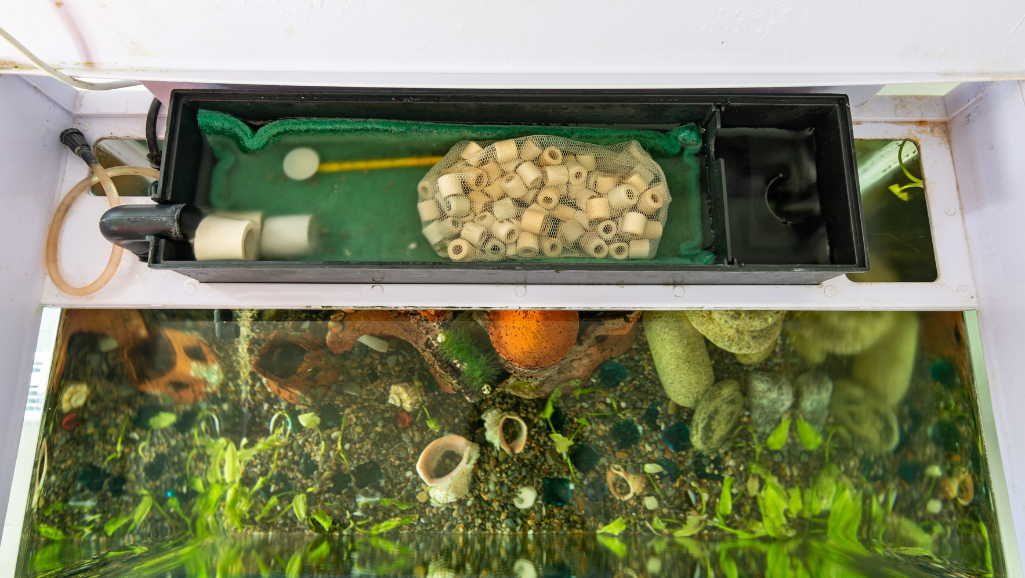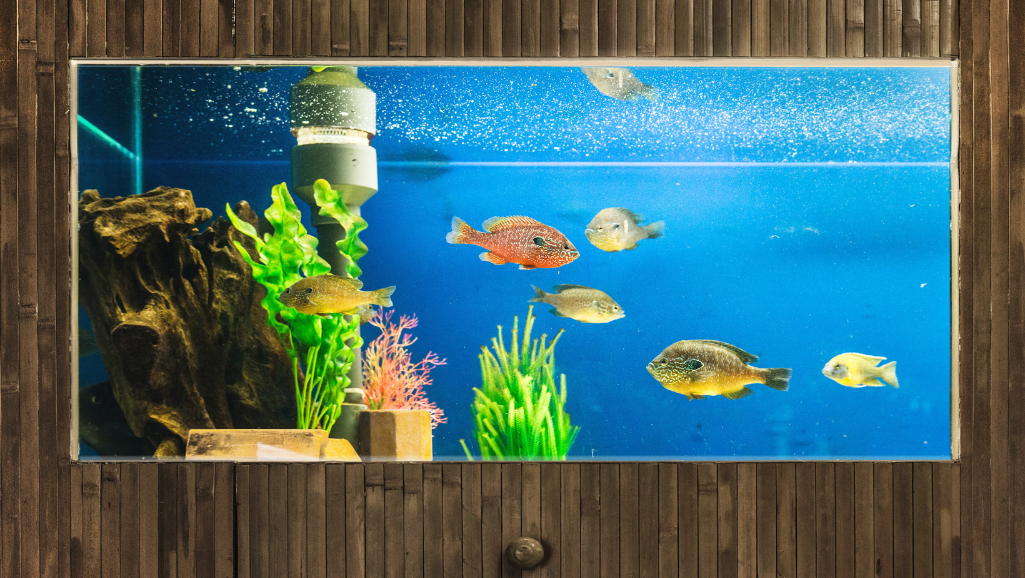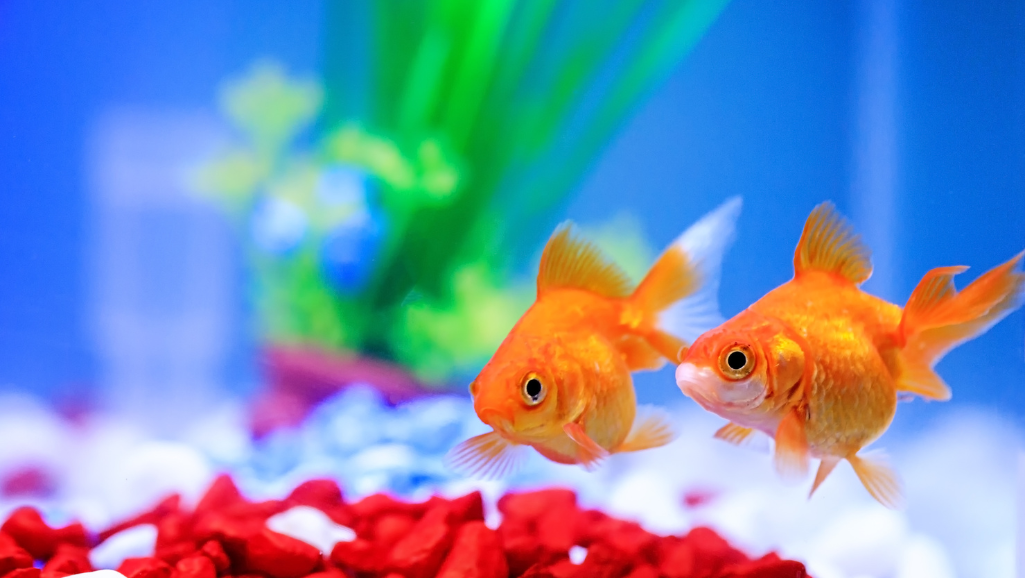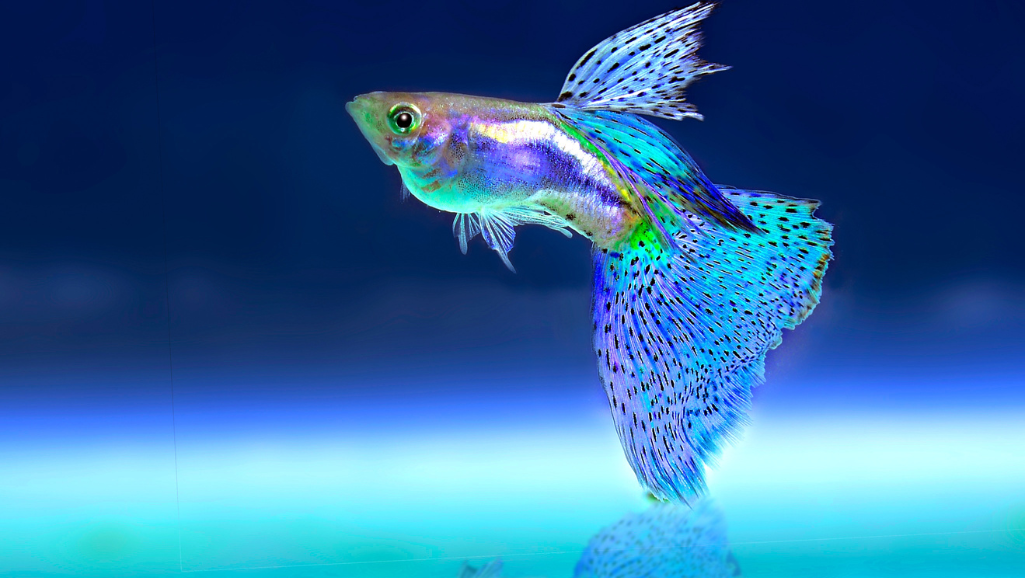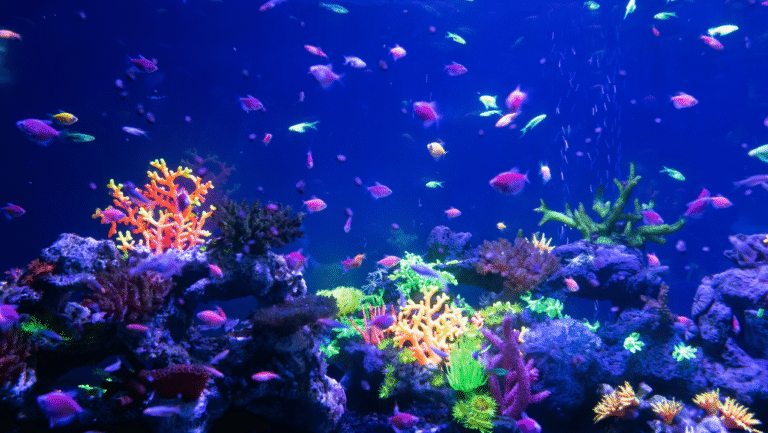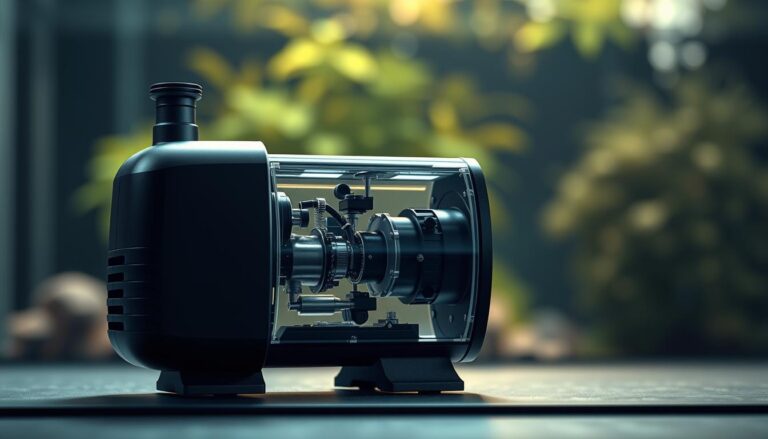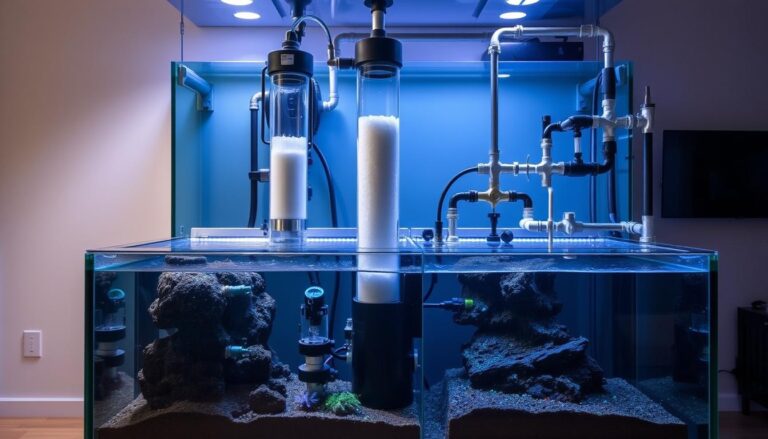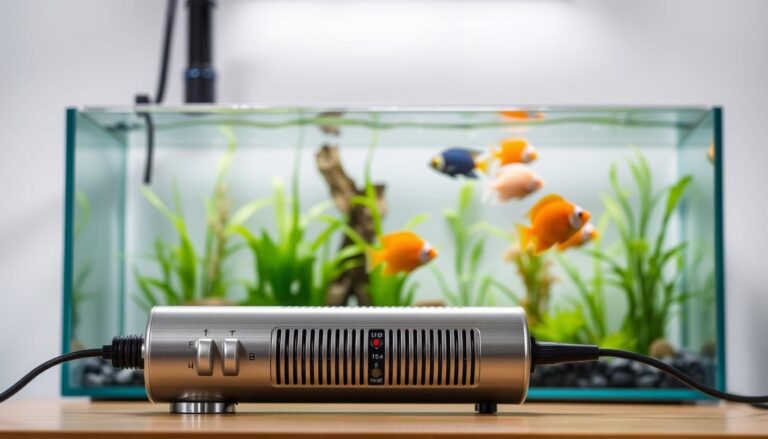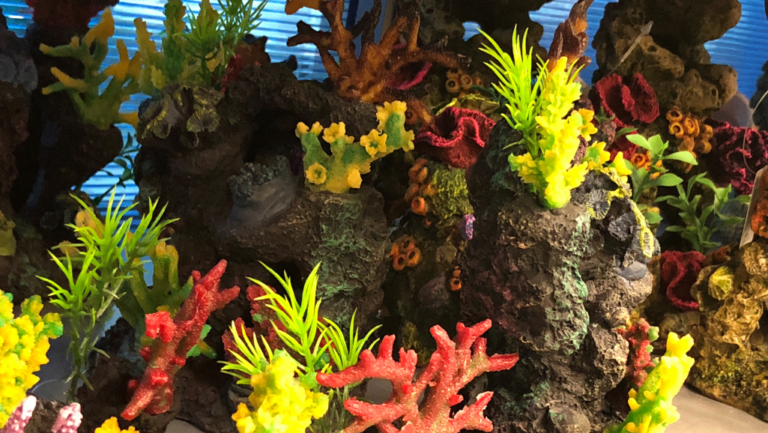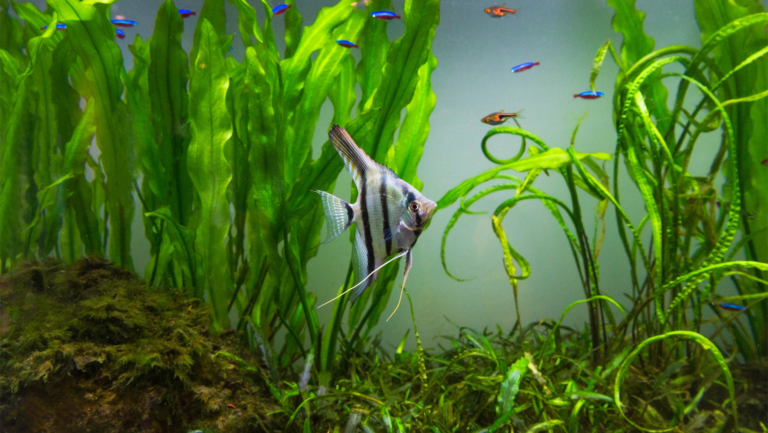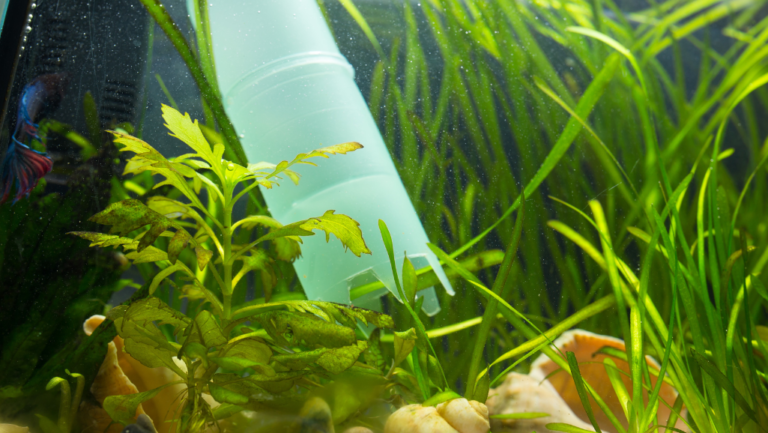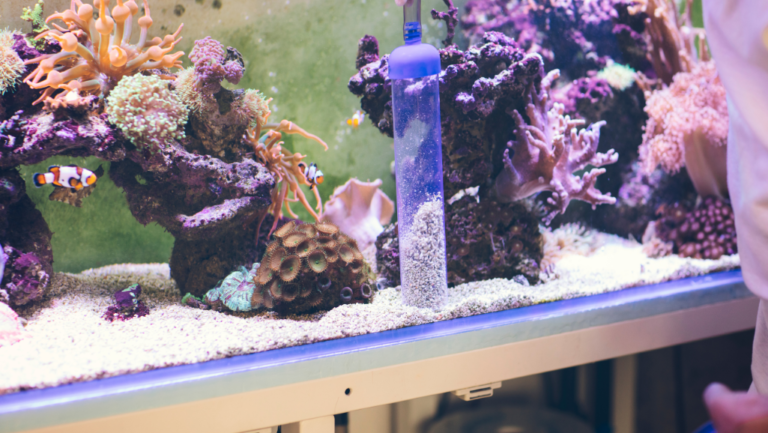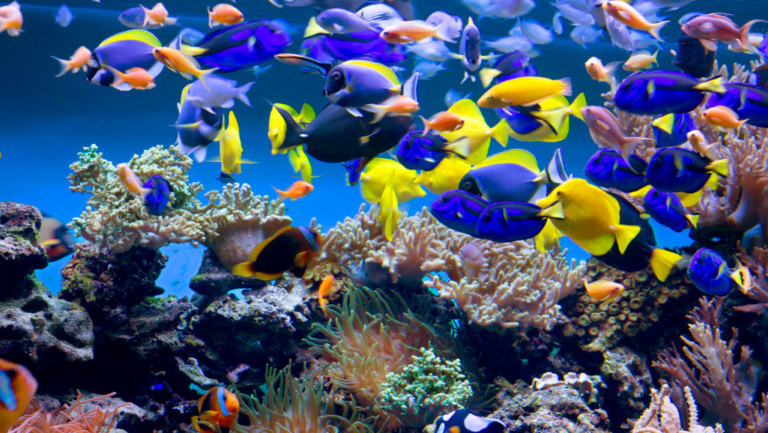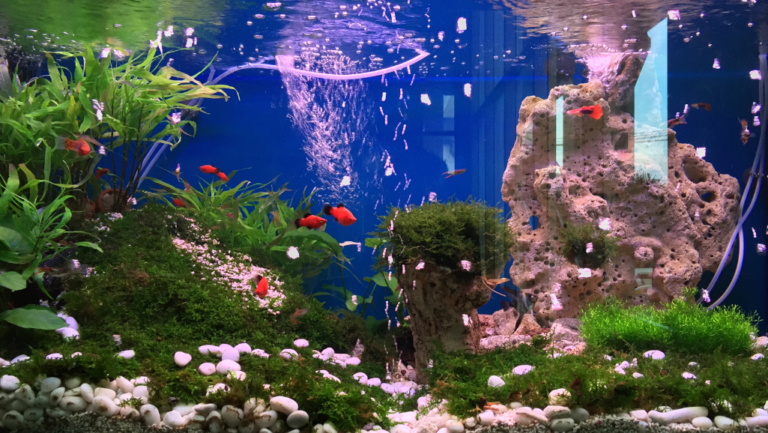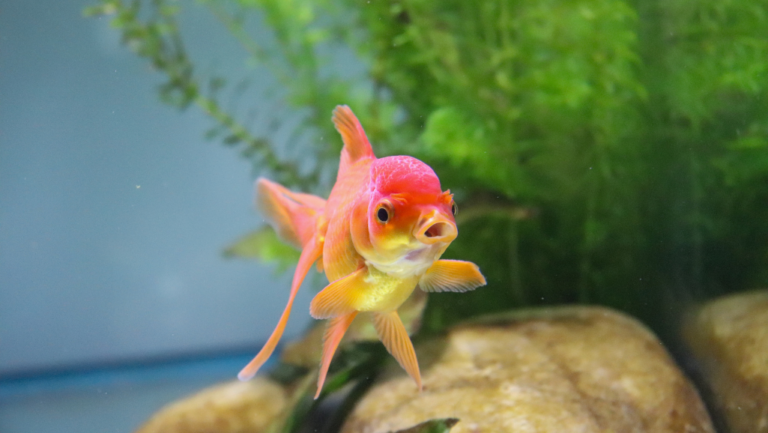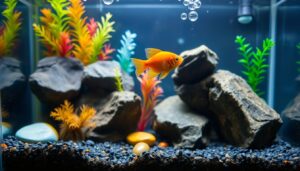Imagine turning your living space into a captivating aquatic sanctuary with a stunning fish tank. Fish tanks can elevate any room’s aesthetic, adding exotic beauty and tranquility. They showcase vibrant fish and lush plants, becoming the room’s focal point.
When choosing a fish tank size, remember larger tanks make a bigger impact. Los Angeles homes often have high ceilings, perfect for 5-foot-tall tanks. Place your tank on a stand 2 to 3.5 feet tall to create a stunning display.
The room’s type and furniture also matter for your fish tank’s visual appeal. Whether in a living room, dining area, or bedroom, a well-placed aquarium can be mesmerizing. With the right supplies and design, any space can become serene and inviting.
For reef tank lovers, coral placement is key. Start coral arrangements 10 feet from the top for best viewing. But, keeping water clear in large tanks is a challenge, requiring careful care.
Designing the tank’s top involves thinking about algae and reflections on viewing windows. Lighting above the tank can also affect the view, with reflections possibly spoiling the display. In dry climates like Los Angeles, waterproof materials are needed for second-floor tank views.
Key Takeaways
- Fish tanks can transform your living space into a captivating aquatic sanctuary
- Larger tanks have a more significant visual impact, even in homes with high ceilings
- The type of room and furniture around your tank affect its aesthetic
- Proper coral placement and water clarity are vital for reef tanks
- Designing with care, like lighting and evaporation, improves the viewing experience
The Beauty of Aquatic Life in Your Home
Turn your home into a peaceful oasis with the beauty of aquatic life. Aquariums have become more popular in 2023. They add beauty and calm to your space. Custom aquariums are like living art, showing off vibrant corals, exotic fish, and stunning aquatic landscapes.
Imagine coming home to see your own underwater paradise. Watching fish can lower blood pressure and reduce stress. Aquariums are great for your mental health, making your home more relaxing.
Enhancing Aesthetics with Fish Tanks
Fish tanks are good for your mind and look amazing. AQUA VIM has many designs for corner tanks. Their curved glass gives a wide view, making the tank seem bigger.
“Aquariums are not just a hobby; they are a living art form that brings the beauty of the underwater world into your home.” – marine biologist, Dr. Emily Thompson
Creating a Tranquil Environment
Aquariums are not just pretty; they’re also good for families. They offer a calm space, helping you feel better. The sound of water and the filter’s bubbles create a peaceful vibe.
Aquariums are also great for learning, like for kids. They teach about biology, ecology, and oceanography. With proper care, your aquarium can be a thriving underwater paradise that brings joy every day.
Choosing the Right Size Fish Tank
Creating an underwater paradise at home starts with the right tank size. The size should match your space and the look you want. You can turn any room into a stunning aquatic oasis with the right tank.
Factors to Consider for Your Space
Before starting your fishkeeping journey, think about your living space. Consider these factors for the perfect tank size:
- Available floor space or wall area
- Weight capacity of the chosen location
- Accessibility for maintenance and viewing
- Compatibility with your interior design style
A full fish tank can weigh at least 10 pounds for every gallon. Make sure your spot can handle the weight. Aim for one gallon of water per inch of fish when picking a tank size.
Common Size Options Explained
Fish tanks come in many sizes to fit different spaces and tastes. Here are some popular options:
- Nano Tanks (less than 10 gallons): Great for small spaces or as a desktop companion. They need more frequent care because of their small size.
- Beginner-Friendly Sizes (20-30 gallons): Ideal for new hobbyists. These sizes offer space for many fish and easy maintenance.
- Medium-Sized Marvels (55-75 gallons): Medium tanks offer more room for fish to show their natural behaviors. They create a stunning underwater display.
- Large-Scale Wonders (100+ gallons): For a deep dive into the ocean, large tanks are perfect. They allow for elaborate aquascaping and can hold bigger fish species.
“The best way to choose the size of the tank is to purchase the biggest tank within your budget that will fit comfortably in the location you have chosen.”
Remember, bigger tanks are often better. They offer a stable environment, diluting waste and keeping water parameters stable. They also let you have more fish and impressive aquascaping, turning your space into an underwater oasis.
Whether you choose a mesmerizing living room wall fish tank or a calming headboard fish tank, the right size will make your dream come true.
Understanding Different Types of Fish Tanks
Creating a captivating aquatic display in your home is exciting. Knowing the different types of fish tanks is key. Each type, from freshwater ecosystems to reef tanks, has its own charm and challenges.
Freshwater tanks are more affordable and easier to care for than saltwater tanks. They can host many fish species, plants, and decorations. This lets you create a thriving underwater world in your living room. With the right care, a freshwater tank can bring years of joy and relaxation.
Freshwater vs. Saltwater Tanks
Saltwater aquariums, like reef tanks, show the mesmerizing world of marine life. They need special equipment and care but are loved for their stunning colors and unique species. A well-kept reef tank can feel like a tropical paradise.
Specialty Aquariums for Unique Species
Specialty aquariums offer a unique experience for specific species. African biotope aquariums, for example, mimic African cichlids’ natural habitats. These tanks have a rocky landscape and can feature colorful African cichlids and striking red-tail sharks.
“Keeping fish is a delight and a lesson of life; it is a source of knowledge and wisdom.”
Choosing a fish tank means caring for a living ecosystem. Each tank has its own needs and characteristics. By understanding these, you can create a thriving underwater world that brings joy and peace to your home.
Essential Equipment for Fish Tanks
Setting up a thriving aquarium is more than just adding water and fish. You need essential equipment for a healthy environment. This includes water quality and lighting systems. Let’s look at the key components for every fish tank.
Filtration Systems: Keeping Water Clean
Filters are vital for any aquarium, working hard to keep water clean. Choose a filter based on your tank size and fish number. A 20-gallon tank needs a filter rated at least 60-100 gph for good filtration.
Cabinet aquariums hide filters and pipework, making your setup neat. Include a digital thermometer for temperature checks and a heater to keep water at 75-79°F.
Lighting Solutions for Healthier Fish
Good lighting is key for your aquarium’s beauty and fish health. For fish-only tanks, use 1-2 watts per gallon. For planted tanks, use 2-5 watts per gallon. LED bulbs are energy-efficient and last long, with various colors to enhance your tank.
Blue accent lights add a mesmerizing moonlight effect. They complement your main lighting, making your tank a stunning room feature.
Quality equipment from the start saves time and money. It ensures a thriving underwater world for your fish.
Selecting the Perfect Fish for Your Tank
Choosing the right fish for your aquarium is key to a healthy and peaceful underwater world. With so many fish to pick from, it can feel overwhelming. Let’s look at some popular freshwater fish and how to care for them.
Schooling Fish: A Mesmerizing Display
Schooling fish are loved for their beautiful swimming together. Some great choices include:
- Cardinal Tetras: These fish are a vibrant red and blue, adding beauty to any tank.
- Harlequin Rasboras: Their red and black colors make them elegant and peaceful.
- Zebra Danios: These active fish have bold stripes, making them a great sight.
It’s important to keep at least five schooling fish together. This makes them feel safe and shows off their natural behavior. Other great choices are neon tetras, rummy nose tetras, and black neon tetras.
Peaceful Community Fish
For fish that get along well in a community tank, consider these:
- Guppies: These colorful fish are easy to care for and brighten up your tank.
- Platies: Hardy and adaptable, platies are perfect for beginners.
- Cory Catfish: These cute bottom-dwellers clean your tank by eating leftover food.
“The key to a successful community tank is selecting fish with similar temperaments and water requirements.”
Make sure to research each fish’s needs to ensure they live well together.
Think about your tank’s size, water conditions, and the balance of your ecosystem when picking fish. Start with a few and add more slowly. This lets your tank adjust. By choosing the right fish and caring for them, you can make a beautiful aquatic home.
Aquascaping: Designing Your Underwater Paradise
Aquascaping is the art of creating stunning underwater landscapes. It brings the beauty of nature into your home. With a Dutch garden-themed aquarium, you can enjoy a lush and vibrant display of greenery, reminiscent of a meticulously manicured garden.
When designing your aquascape, consider the Rule of Thirds. This principle involves dividing your tank into thirds, both horizontally and vertically. Place focal points at the intersections. By strategically positioning plants and decorations, you can draw the eye to specific areas and create a sense of depth and balance.
Plants and Decorations to Consider
Selecting the right plants is key for a lush and thriving aquascape. Some popular choices for Dutch garden-themed aquariums include:
- Stem plants like Rotala and Ludwigia for their vibrant colors and dense growth
- Carpeting plants such as Hemianthu callitrichoides and Glossostigma elatinoides to create a lush, grassy foreground
- Red plants like Alternanthera reineckii to add a striking focal point and contrast
For hardscaping, choose materials that complement your theme. Natural stones and driftwood can add texture and depth. They also provide hiding spots for your fish.
Tips for Maintaining a Balanced Ecosystem
To keep your aquascape looking its best, regular maintenance is essential. Perform weekly water changes to remove toxins and replenish nutrients. Trim plants as needed to promote healthy growth and maintain their desired shape.
“The key to a successful aquascape is finding the perfect balance between plants, fish, and decor. It’s a delicate art that requires patience and attention to detail.” – Takashi Amano, renowned aquascaper
Remember to consider the compatibility of your fish with your chosen plants and decor. Select species that thrive in similar water conditions and have complementary behaviors. This ensures a harmonious and thriving ecosystem.
Regular Maintenance and Care Tips
To keep your fish tank beautiful and healthy, you need to care for it regularly. A cleaning routine and watching the water are key. If you ignore these steps, your fish might get sick.
Establishing a Cleaning Routine
Keeping your tank clean is vital. Experts say to change 15% to 25% of the water every couple of weeks. This removes waste and adds important minerals. Also, don’t forget to:
- Remove uneaten food and debris daily
- Clean the tank walls and decorations with an algae scrubber
- Replace mechanical filter media like foam once or twice a year
- Inspect and clean tubes and filter intakes as needed
Having the right tools makes cleaning easier. You’ll need an aquarium bucket, siphon, algae scrubber, filter brush, and more. These tools will help you clean your tank well.
Monitoring Water Conditions
It’s also important to check your tank’s water quality. Monthly water testing for pH, ammonia, and other levels is a must. Aim for these ranges:
- pH: 6.8 to 7.8 for freshwater tanks
- Ammonia: 0 parts per million (ppm)
- Nitrite: Below 0.75 ppm
- Nitrate: Under 40 ppm
- Phosphate: Below 0.2 ppm
“Regular tank maintenance and water quality monitoring are the keys to creating a thriving aquatic environment for your fish.”
By following a cleaning routine and checking the water, you’ll have a stunning fish tank. It will bring joy and peace to your home for many years.
The Health Benefits of Having Fish Tanks
Adding a fish tank to your home does more than look good. It can help you feel better, too. Watching fish swim can lower stress, boost your mood, and even clean the air. It’s a simple way to make your home a healthier place.
Stress Relief and Mindfulness
Fish tanks are great for reducing stress and helping you relax. Studies show they can lower blood pressure and heart rate. The sound of water and fish movements creates a peaceful space.
Watching your fish can also be a mindfulness practice. It helps you focus on the moment and forget worries. This can bring you peace and happiness.
Improving Indoor Air Quality
Fish tanks also improve the air in your home. They add moisture, which can help with breathing problems. The plants in your tank clean the air by removing carbon dioxide and adding oxygen.
“Fishkeeping is not just a hobby; it’s a way to bring a piece of nature into your home and experience its calming influence every day.”
Having a fish tank can turn your home into a calm oasis. It’s perfect for reducing stress, improving mood, or just making your air cleaner. A beautiful aquarium can make your home a peaceful retreat.
Fish Tanks as Educational Tools
Fish tanks are more than just pretty decorations. They are great for teaching kids about responsibility and the world of aquatic life. By having an aquarium at home, you can turn your living space into a science project.
Research shows that 75% of classrooms find aquariums helpful for learning. Also, 80% of teachers say they help teach responsibility. Fish tanks are more popular than other pets in classrooms, with a 3:1 ratio. Using aquariums in education boosts student interest by 65%.
Teaching Kids About Responsibility
Looking after a fish tank teaches kids about responsibility. Tasks like feeding, checking water, and cleaning the tank show the value of caring for living things. In fact, 70% of classrooms include fish tank care in their lessons, with activities like measuring water temperature being favorites.
Creating a Living Science Project
Fish tanks are full of learning opportunities. They can teach about food chains, water cycles, and biology. By studying fish, students learn about aquatic ecosystems. Aquariums also help teach chemistry, ecology, and physics.
Letting students pick and arrange fish tank accessories encourages creativity and problem-solving. This makes learning fun and engaging.
“Aquariums bring children and parents together, creating a shared learning and excitement experience.”
Adding fish tanks to classrooms improves learning and creates a calm atmosphere. The quiet of an aquarium helps kids who are upset or have ADHD, autism, or sensory issues. It gives them a peaceful place to relax.
Making Your Fish Tank a Focal Point
Turn your fish tank into a stunning focal point in your home. It can make your space more inviting and create a magical underwater world. By placing your tank in the right spot and adding matching decor, it becomes the heart of your room’s design.
Tips for Positioning and Viewing
Choose a spot for your tank that catches the eye and gets plenty of light. Putting it at eye level lets you see it best. Make sure it’s easy to get to for upkeep and avoid places with too much heat or sun, which can cause algae.
Enhancing Your Space with Surrounding Decor
To really make your tank stand out, think about what goes around it. Pick colors and textures that match your tank’s look. You might want to add:
- Accent lighting to show off the tank’s beauty
- Art or wall colors that match
- Comfortable seats for enjoying the view
- Decorative stands or cabinets for support
“A well-designed aquarium can transport you to another world, creating a serene and captivating focal point in any room.”
By carefully choosing where your tank goes and what decor surrounds it, you can create a beautiful display. It will show off the beauty of underwater life and improve your room’s look.
Sustainable Fishkeeping Practices
We have a big responsibility as aquarium lovers. We must make sure our fishkeeping is good for the planet. By picking the right products and fish, we can help the environment and keep aquatic life healthy.
Choosing eco-friendly products is a great start. For example, using aquacultured freshwater plants is good for the environment. They help keep ecosystems diverse and natural.
In saltwater tanks, picking coral from sustainable farms is better than wild coral. This choice is more ethical and helps protect coral reefs.
Supporting Local and Sustainable Suppliers
Buying from local shops and breeders is key to sustainable fishkeeping. It cuts down on shipping and supports local businesses. Choosing captive-bred fish helps protect wild populations and ecosystems.
Energy-Efficient Equipment and Practices
Using energy-saving gear is another way to be green. LED lights, efficient pumps, and heaters use less power. A timer for your lights can also save energy by matching day and night cycles.
“As fishkeepers, we have the power to make a difference through our choices and actions. By embracing sustainable practices, we can enjoy the beauty of aquatic life while protecting the environment for future generations.”
It’s important to research fish to ensure they fit well in your tank. This avoids introducing invasive species. Understanding your fish’s needs helps keep them healthy and reduces the need for harmful treatments.
By following sustainable fishkeeping and making smart choices, we can create amazing aquariums. These not only show off the beauty of fish but also help protect our planet. Let’s work together to make fishkeeping a green and responsible hobby.
Inspiring Stories from Fish Tank Enthuisiasts
Fish tank lovers from all over the world have found joy and purpose in their hobby. From Thailand to Iceland, they’ve created amazing aquariums. These stories show how fish tanks can change our lives for the better.
How Fish Tanks Changed Their Lives
For many, fish tanks are more than a hobby. They’ve become a big part of their lives. Studies show that fish tanks can make us less stressed and happier. This is true for those who love the underwater world.
One enthusiast spends $100,000 a year on their tank. They also spend three days a week keeping it clean. Their dedication is truly inspiring.
Creative Designs and Unique Setups
Fish tanks are a blank canvas for creativity. Enthuisiasts are always coming up with new ideas. They create stunning designs and special tanks for unique fish like seahorses.
One tank has become famous worldwide. A YouTube channel about it has 850,000 visitors from 135 countries. The community forum has over 2,250,000 views. It shows the beauty and innovation that can happen with fish tanks.
These stories remind us of the amazing impact fish tanks can have. They make our homes more beautiful and give us a sense of purpose. Let’s keep exploring the underwater world and celebrate the beauty of fish tanks.

